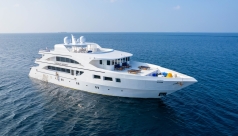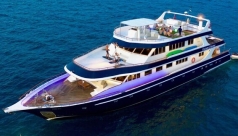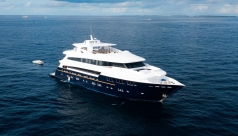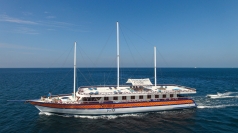Dive Destinations
Liveaboards
Resorts / Day Trips
Scuba Training
...Highlights: shark action, schooling fish & big pelagics...
...Diving environment: drift diving, caverns, advanced divers...
Kandus, or channels, are a major feature of South Male. On the eastern reef wall there are 6 channels through which a huge volume of water gushes, bringing with it all the nutrients to attract large quantities of marine life. Coral coverage here is not what it is in other areas so if pristine reefs are your thing, the atolls of North Male and Ari may have more to offer. The scuba diving at South Male Atoll (also known as South Kaafu) on the other hand features fish in schools of sizeable numbers, big pelagic fish, plenty of soft corals and caves as well as one very good wreck, and is considered one of the best liveaboard diving areas in the Maldives.
Cocoa Thila is South Male's most revered dive site. It is a large, deep water pinnacle on the outer edges of the atoll, its many ravines and overhangs provide divers with refuges in which to shelter from the strong currents that attract grey reef sharks, eagle rays and large schools of fusiliers. Larger reef fish can be observed too, such as sweetlips, snappers and groupers.
Guraidhoo Kandu South is a large underwater region with a variety of channels, reef plateaus, walls and drop-offs. The diversity of topography is reflected in the many animal attractions here, from moray eels, lionfish, squirrelfish, soft corals and fans occupying the colourful chamber dwellings, to schooling trevallies and sharks patrolling the reef channels and walls.
The atoll of South Male is separated from North Male by the Vaadhoo Kandu channel, on the other side of which is the capital Male City. This means it has strong ties to the capital in terms of economic and cultural influence, and that the travel time from the international airport to many parts of South Male Atoll is comparable to that from North Male.
The strength of the current will determine how much fun you have on this site. Insufficient current can mean no fish. Ripping current can mean that after a minute or so there are no divers! Moderate current means you will experience one of the Maldives' finest sites. Your dive guide should know when conditions are right and, when they are, you will see a whole host of marine life.
The thila, or pinnacle, is some 400 metres in length and slopes down to a drop-off at 30 metres. At this spot if you concentrate on the blue you where are likely to spot tuna, trevallies and even eagle rays, either in isolation or a squadron of them flying in formation.
There are a number of overhangs and caverns here and it is often worthwhile to duck into these to avoid the current and allow you to relax and enjoy the views of sweetlips, fusiliers and rock cod. Grey reef sharks are also prevalent at Cocoa Thila so keep an eye out for them at the 30 metre mark and at the southwest corner of the thila. Also at this spot is a series of ravines where snappers, trumpetfish and sharks all seem to linger.
Sometimes the current here can surprise even the most experienced of guides so it is worth planning your dive to include a series of 'rest stops' in sheltered locations. Even if the current is not so strong these are often the best vantage points anyway. So provided conditions are conducive, you can drop in here and enjoy one of the most colourful and active dive sites in the South Male area.
This channel, in the northeast of South Male Atoll, is one of the first names on divers' lips when someone mentions sharks. It is a marine protected area precisely because of the population of grey reef sharks and white tips that it supports.
You will begin this dive by dropping in on the south side of the channel and then sinking down to the edge of the abyssal drop at around 30 metres. Here is the spot to linger for a while, checking out the sharks, rays and Napoleon wrasse that pass by in the blue just off the reef wall. After a few minutes of taking in the action you will be led around the corner with the wall on your left shoulder where there are a series of caverns and caves sheltering marbled groupers and soldierfish. There is one particularly large cave to be explored which is festooned with colourful sponges. It's worthy of penetration since it goes back almost 25 metres.
Your dive here is likely to end by enjoying the drift through a narrow canyon that splits into the channel at about 15 metres, before continuing to go with the flow into the shallows.
There is another area here which is more or less a dive site in its own right - the north side of the channel. Here there is a thila which rises up to 12 metres from a base of around 30 metres, and you can spend a good 45 minutes checking out this thila alone, particularly if you are a photographer. The walls are covered in soft corals and hard corals and provide shelter for an impressive range of marine creatures including moray eels, octopuses and lionfish.
Returning to your liveaboard from this dive you will probably marvel at the range of fish and pelagics you have just witnessed, and you may also remark on the calm conditions of the cave. However, the distance covered from entry to exit on this excellent drift dive is often its most remarkable feature.
Often considered among the most impressive locations for fish life and photography, not only at South Male Atoll but in the entire Maldives. Guraidhoo Kandu is one that is topographically complex, consisting chiefly on 2 channels and a central reef. It also covers a large area and is really a spot that can be dived several times in different ways and is sometimes subdivided into several individual sites.
The southern channel (often considered a dive site in its own right) is a stretch that runs for around 300 metres and is flanked on each side by vertical walls, past which you will drift effortlessly in the prevailing current. Where the southern channels meet the abyssal drop at around 35 metres, there is often a lot of action such as jacks, Napoleon wrasse and grey reef sharks.
The reef wall provides plenty of current-free indentations where you can take 5 and check out the resident marine creatures, including honeycomb moray eels and long-jawed squirrelfish. There are an impressive number of soft corals, sea fans, black coral bushes and other sessile colour, particularly inside the channel where at 30 metres there is an archway covered on soft corals - a real Kodak moment in the right light.
It's considered one of the best dive sites in South Male Atoll. The thila (pinnacle) is located just outside Kandooma Island, on the north side. A fairly small pinnacle that reaches it shallowest point at 13m, while the sandy bottom is at 35-40m depth. It's shaped as a teardrop. The small channel between the thila and the reef usually creates a strong outgoing current that runs west to east. Here is where the show happens and therefore where scuba divers and you need to be.
Once in the water, a negative descent is the rule, in order to quickly reach the western point of the pinnacle, called Jack Corner. Here is where most of the dive time is spent simply gazing at all the hunting action that the current brings close to the thila: barracudas are usually in groups, while grey reef sharks and white tips seem to prefer hunting alone. Anthias and glass fish make an easy target for hungry trevallies, while other types of fish such as groupers and snappers prefer to find shelter from the current among the hard coral blocks scattered all over the pinnacle.
After several minutes at depth, the dive usually continues by choosing one of the 2 directions: either by going north or south. The pinnacle itself offer respite from the current and also the possibility of slowly ascending to a depth between 13-16m. Turtles are quite often seen at the top of the pinnacle busy feeding themselves, while Napoleon wrasse are more likely to pass by, being pushed by the current towards the east side of the reef.
This is where it's most likely to be the end of the dive as the chances of being able to swim against the current, trying to get back to the pinnacle, are very slim. The safety stop is usually done in the blue, making sure that a safety marker buoy is deployed before exiting the water.
To most people this is a wreck dive since the site is dominated by the small wreck that lies upright on the South Male seabed between 30 and 15 metres depth. However the name of the site described the giri, or pinnacle, that is found nearby and this too could be considered a dive in its own right.
You will probably drop to the deepest part of this wreck to begin your dive. However, the currents are often absent or negligible so this is one site the less experienced diver can enjoy. They may wish to stay toward the shallower bow section. The wreck was sunk on purpose to form an artificial reef and has been well and truly colonised by orange, red and yellow sponges, as well as tubastrea cup coral.
When you are scuba diving on the wreck you should look out for the big schools of glassfish that hover together en masse in the interior, little gobies peeking out from various holes, and a large school of batfish that seems to stay around the wreck. Turtles, humphead wrasse and other large reef predators will also put in frequent appearances. The wreck is penetrable in via a couple of different methods, but is small and any group penetration needs to be handled in an orderly fashion.
Outside the wreck the sandy bottom features garden eels, and shrimp and goby partnerships. You can spot leaf-fish in the broken staghorn, and there are plenty of nudibranchs and flatworms in and around the pinnacle. Fissures in the reef also act as home to octopus, moray eels and thin-armed shrimp. Divers can look out for anemones with their resident anemonefish swimming in and out of the stinging fingers.
As with many sites in the Maldives there are countless red-toothed trigger fish fluttering away from the reef only to dart into their protective holes in the reef at the first sign of danger. If you're in luck, you might spot an elusive resting guitar shark here too.
This site is found on the north side of Guraidhoo Kandu in the southeast of South Male and, when current is flowing into the atoll, it is really at its best. After to deflate here you will find yourself descending to begin the dive around a ledge at 30 metres, over which there is a sheer drop into the inky blue nothingness.
Your diving guide will lead you around a corner so you are moving from the outside wall into the channel where the sights really begin. First you will notice that the channel walls are host to beautiful and intricate gorgonians, and whip corals reaching their long thin fingers out into the channel.
Even more colourful and dramatic is the large outcrop of rock which is blanketed in a multi-coloured carpet of soft corals. Circling around this backdrop you will see oriental sweetlips, bannerfish and butterflyfish. On the channel floor there is a sandy bottom where blue-spotted rays and ribbon eels are among the easier residents to spot. Back on the corner, as you work your way around, there is a dramatic drop-off which has a lot of overhangs and crevices in which you are likely to spot unicornfish and emperor angelfish.
As the name suggests this site, located along the northern coast of the South Male Atoll, offers scuba divers the opportunity to explore several caves and caverns. Dipping into each one is like stepping of a conveyor belt into the relative calm of each cavern before re-emerging to be carried to the next.
The line of caves and ledges runs along the northern wall of the island and is dominated by soft corals in a variety of blue, green and yellow, providing a beautiful backdrop for photography. The caves vary in depth with entrances to them ranging from 7 to 40 metres.
When you work your way into the caves you will be able to take your time and check out the other life forms sheltering here, such as soldierfish, turtles, and unicornfish. The caves also vary in size but obvious cautions, such as maintaining neutral buoyancy at all times and divers moving in order, should prevent any unintentional contact with the walls or ceilings.
From inside the caves, if you look out, you will be able to see the larger visitors to the area, including whitetip sharks and tuna swimming in the blue, often framed in view by their colourful entrances. Eagle rays are often seen swimming effortlessly over the reef, which is among the most pristine you will find in the Maldives.
Your guide will lead you past the caves area and, gradually rising in the water column, you will find yourself in the shallows from 8 metres or so, which is a beautiful location in which to end the dive, such is the colour and activity in the nooks and crannies of the reef. Currents may sweep through here and separate you from your group towards the last few minutes of the dive so the use of a safety sausage is advisable.
In contrast to North Male, the atoll of South Male is more developed in terms of the number of resorts as a consequence of being one of the first to open to tourism. However the diving is no less rewarding and is a popular area for liveaboards to include in their itineraries.
For more information on the cruise routes and all the other travel information you might need to visit Maldives, read Central Atolls liveaboards section.
Competition for spaces on boats is strong and many are fully booked months before the departure dates, so we urge our customers to book no less than 6 months prior to the proposed dates of travel.

Customer rating: Excellent!

Customer rating: Excellent!

Customer rating: Excellent!

Customer rating: Excellent!

Customer rating: Excellent!

Customer rating: Excellent!

Customer rating: Excellent!

Customer rating: Excellent!

Customer rating: Excellent!

Customer rating: Excellent!

Customer rating: Excellent!

Customer rating: Excellent!

Customer rating: Very good!

Customer rating: Very good!

Customer rating: Very good!

Customer rating: Very good!

Customer rating: Very good!

Customer rating: Very good!

Customer rating: Very good!

Customer rating: Very good!

Customer rating: Very good!

Customer rating: Good

Customer rating: Good

Customer rating: Good

Customer rating: Good

Customer rating: Good

Customer rating: Good

Customer rating: Average

Customer rating: Average

Customer rating: Below average

Customer rating: Be first to rate!

Customer rating: Be first to rate!

Customer rating: Be first to rate!

Customer rating: Be first to rate!

Customer rating: Be first to rate!

Customer rating: Be first to rate!

Customer rating: Be first to rate!

Customer rating: Be first to rate!
Scuba diving vacations are possible in South Male all year round, though surface conditions are generally best during the Northeast Monsoon season from late December to May. Confirmed liveaboard departures run from November to May. If you wish to come outside of these months then it may be more difficult to find a departure date that suits you.
The Southwest Monsoon runs from June to November and brings with it a greater chance of rain and less calm seas. However, rainfall here is less than in the Southern Atolls of the Maldive Islands.
Water temperatures at South Male Atoll hover around the bathtub mark of 26 to 29°C, although thermoclines at depth can bring abrupt changes. Visibility, like elsewhere in the Maldives, is 15-30+m all year round, depending on which side of the atoll you dive in which season. For more on the climate and sea temperature at Male City, visit Weather Atlas.
Manta rays, reef sharks, turtles and Napoleon wrasse are here throughout the whole year.
Review our maps below of South Male Atoll and its host country Maldives. Here, you will find information on how to get to the Maldives, and then cruise on to South Male.
5 - >40m
10 - 30m
Can be very strong
Calm but can be choppy in southwest monsoon
26 - 29°C
Intermediate - advanced
>20
6 km south of North Male
7 - 10 days
Last minute changes were accommodated quickly, responses were timely and pleasant. [Your sales person] was great to work with
